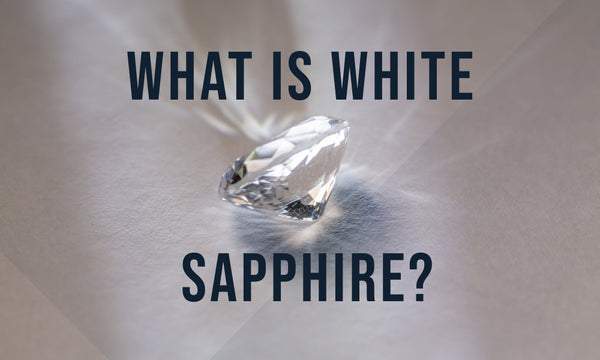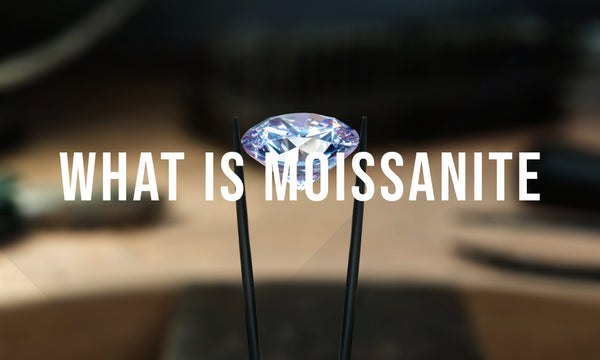White sapphire and moissanite are some of the most popular diamond alternatives. Each stone has unique attributes, making them the perfect choice for those seeking something other than a diamond. But, which is better, moissanite or white sapphire?
Both are colorless, durable, and beautiful, but what is the difference? This blog post will cover all aspects of both stones, offering easy-to-remember facts by pointing out the pros and cons of white sapphire and moissanite, making choosing between white sapphire and moissanite rings an exciting experience.
What is White Sapphire?

White sapphire refers to the colorless/clear variety of sapphire, a variety of the mineral family corundum. Corundum is a naturally occurring crystalline form of aluminum oxide (chemical formula Al2O3) found in metamorphic, sedimentary, and igneous rocks. Corundum contains trace amounts of elements such as iron, titanium, chromium, vanadium, or magnesium, which results in its color. Some of the richest deposits of corundum are found in India, Myanmar (Burma), Russia, Zimbabwe, and South Africa.
Sapphire has a refractive index of 1.762 to 1.770 and vitreous luster, with a birefringence of 0.008 to 0.010 and a specific gravity (SG) of 4.00. The refractive index (fire) measures the bending of a ray of light when passing from one medium into another (Britannica). Specific gravity refers to the density of the mineral, with each mineral having an identifying SG, distinguishing them from each other.
According to the Gemological Institute of America (GIA), the name sapphire can apply to any corundum that isn't red--this is because red is the designated color for ruby, the other corundum variety.
Pros
Durability: Sapphire (corundum) is a very hard and durable mineral, rating 9 on the Mohs scale of hardness. The Mohs scale of hardness is a scale developed to test and rate the hardness of minerals, using a ranking scale of 1-10. Corundum is behind diamond (10), famous for its hardness, and moissanite, which rates 9.25. This makes corundum perfect for cutting, faceting, and jewelry making.
The Big 3: Sapphire is part of the “Big 3,” a classification encompassing sapphires, rubies, and emeralds as important gemstones in the jewelry industry and design that are rare, sought-after, and prized. This classification sets them apart from other semi-precious gemstones, like citrine, amethyst, aquamarine, and blue topaz. Sapphires command a higher price per carat compared to these and other semi-precious gemstones.
Natural Diamond AlternativeIf you are seeking something as a diamond replacement, a white sapphire with the same cut and caratage is more affordable. White sapphires can be faceted and cut into all the same shapes of a diamond or moissanite, including marquise, round brilliant cut, pear shaped, princess/square, emerald, and more.
Cons
Color: As mentioned above, white sapphire is the colorless or “clear” variety of sapphire. White sapphires exhibit a mirky, gray or yellowish color with lower brilliance than diamonds and moissanite. Sapphires are almost always heat-treated, giving them an all-over saturated color or removing color and other impurities from the stone.
Brilliance: White sapphires may appear as a diamond from first glance, but lack the fire of moissanite and diamond. The bigger the stone, the more obvious the differences appear.
Look-a-likes: White sapphire may be mistaken for more affordable rock crystal quartz, colorless beryl (goshenite), and white topaz, all of which are also colorless/clear naturally occurring semi-precious stones sourced from the earth.
What is Moissanite?

Natural moissanite is rare and very expensive, found in the upper mantle rock and meteorites (Gem Society). In 1893, Nobel Prize-winning chemist Dr. Henri Moissan discovered natural moissanite in Arizona. Moissanite is even rarer than diamonds!
Moissanite has a high refractive index of 2.65 to 2.69 with noticeable double refractivity and an adamantine luster with a specific gravity of 3.22.
How is Moissanite Created?
Because natural moissanite is rare, scientists found a way to recreate it in a laboratory. Production of lab-grown moissanite started in the 1990s.
Moissanite is composed of silicon carbide (SiC), with a carbon atom surrounded by four silicon atoms in a tetrahedral form. Synthetic moissanite is formed under controlled conditions using a combination of pressure and heat. It can take 2-3 months to produce a gem through a long, arduous process.
Pros
Affordability and price: Moissanite has gorgeous and show-stopping fire and brilliance, costing significantly less than a diamond, and perfect for those who love high sparkle.
Durability: Moissanite rates 9.25 on the Mohs scale of hardness, making it second to diamond which rates a 10. This makes moissanite scratch resistant and hard, perfect for setting into engagement or statement men’s rings.
Fire & Brilliance: Moissanite has a very high refractive index, higher than a diamond. It is the most brilliant stone on earth!
Socially conscious and eco-friendly: Moissanite is a lab-created gemstone, making it a sustainable and ethical selection instead of diamonds. Lab-created stones do not go through the mining process or harsh work conditions.
Availability: moissanite is readily available for purchase, ranging in colors, sizes, and quality. This makes finding the preferred price point for any budget easy.
Cons
Appearance: Since moissanite has a higher refractive index with its incredible double refractivity and stunning rainbow-colored flashes of light, people may prefer a more subdued appearance. The fire and brilliance may seem overwhelming.
Not Rare or Precious: Precious stones and diamonds are considered rare and valuable, which is part of their appeal, sought-after, and prized for their exclusivity. Moissanite is a lab-created gemstone that is abundantly available in different sizes and at affordable price points.
Low Resale Value: Since moissanite is made in a lab, it may not have the same resale value as diamonds and other precious stones.
Differences Between White Sapphire and Moissanite

Hardness: Both gemstones are hard and durable. Moissanite rates 9.25, and white sapphire rates a 9 on the Mohs scale, making them both scratch resistant.
Composition: Moissanite is composed of silicon carbide (SiC), with a carbon atom surrounded by four silicon atoms in a tetrahedral form. Corundum (sapphire) is a naturally occurring crystalline form of aluminum oxide (chemical formula Al2O3) containing iron, titanium, chromium, vanadium, or magnesium, which results in its color varieties.
Appearance: Both white sapphire and moissanite are colorless or clear. Moissanite may exhibit a gray, yellow, or blue tinge with incredibly high brilliance or “disco ball effect.” Sapphire may have a gray or yellowish tint with low brilliance.
Clarity: Both white sapphires and moissanite may be free of inclusions or contain growth characteristics from the formation process. Moissanite typically has tiny needle-like inclusions visible under 10x magnification. White sapphires (like other sapphires) frequently contain tiny mineral crystals or fractures visible under 10x magnification.
Price: White sapphire may be more expensive because it is a natural stone; however, it depends on the seller. Moissanite often commands a higher price point because it offers more benefits and is more in-demand than white sapphire.
Factors to Consider When Choosing Between White Sapphire and Moissanite
Budget:The cost of sapphires depends on the size/caratage, color, clarity (inclusions), and overall quality (blemishes, cut). Moissanite follows the same criteria.
Appearance: Sapphires can be color graded depending on hue, saturation, and tone. Sapphires and other colored stones are graded using a different scale than the 4C's, a scale developed by the Gemological Institute of America (GIA), which is used to judge diamond and moissanite quality on color, clarity, caratage, and cut.
Durability: Both are incredibly durable, making them suitable choices for engagement rings, wedding bands, and other fine jewelry creations. However, moissanite is slightly more durable.
Ethical and Environmental Concerns: Moissanite is man-made in a lab, making it an eco-friendly, socially conscious selection for luxury. Moissanite doesn't go through the mining process of white sapphire, which originates from the earth.
Availability: Moissanite and white sapphire are available for purchase, although white sapphire is considered rare.
Personal Preference: Some may opt for a natural, earth-mined mineral containing the unique characteristics of white sapphire, while others may appreciate the ethical and environmental benefits of choosing synthetic moissanite.
Frequently Asked Questions
Are white sapphires more expensive than moissanite?
It depends on the carat and quality of the stone. Moissanite may be priced higher because of its popularity. Both are typically priced lower than a diamond.
Which stone is more brilliant, white sapphire or moissanite?
Moissanite is the most brilliant stone on earth with a much higher refractive index than white sapphire. Sapphire may appear dull under certain lighting conditions.
Is it ethical to purchase a moissanite instead of a white sapphire?
Moissanite is lab-created without being associated with a strenuous supply chain and environmental costs associated with mining gemstones and diamonds. However, the origin of your natural stone may be conflict-free; conflict-free isn’t always verified.
Are white sapphires or moissanite more resistant to scratches?
Both white sapphires and moissanite are highly durable and resistant to scratches, with moissanite being more scratch resistant due to its 9.25 Mohs rating vs. corundum at 9.
Conclusion
Should you choose moissanite or white sapphire? White sapphire and moissanite are common diamond substitutes. White sapphire is a naturally occurring stone mined from the earth; the name moissanite refers to synthetic or lab-created moissanite even though it may not be sold with words such as "lab-grown, synthetic, man-made” attached to it.
White sapphire is the perfect choice for those who seek a durable natural stone in place of a diamond, making it the great natural diamond alternative. Moissanite is a socially-conscious, eco-friendly, and budget-wise option for those who love incredible fire and brilliance. White sapphire is less brilliant, with a much lower refractive index.
Moissanite may command a higher price tag; the price is related to the quality and caratage of the stone.
REFERENCES:Britannica, Corundum
https://www.britannica.com/science/corundum
GIA,
Britannica, Specific Gravity,
https://www.britannica.com/science/specific-gravity
Specific Gravity
Wikipedia, Sapphire
https://en.wikipedia.org/wiki/Sapphire
Brilliant Earth, Sapphire
https://www.brilliantearth.com/gemstones/buying-guide/sapphire/color/
With Clarity
https://www.withclarity.com/education/gemstone-education/moissanite/clarity
Gem Society
https://www.gemsociety.org/article/white-sapphires-vs-diamonds/
Gem & Co.



































































